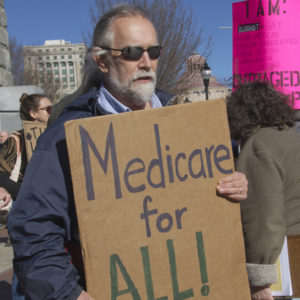Democrats can’t stop talking about single-payer health care. Most of those vying for the party’s presidential nomination in 2020 have declared their support for the idea, which first rose to national prominence during the 2016 Democratic primary that pitted Hillary Clinton against longtime single-payer champion Bernie Sanders.
In February, Sanders — the pied piper of single-payer — declared his candidacy for the White House. Congressional Democrats, meanwhile, are lining up behind bills that would expand or totally reinvent Medicare. But single-payer isn’t going anywhere unless Democrats reclaim the White House and Senate and keep the House in 2020.
Some blue-state governors aren’t willing to wait that long. Connecticut, Nevada, Illinois and Minnesota are looking at schemes that would allow anyone to buy into Medicaid. Washington governor Jay Inslee and his allies in the state legislature plan to introduce a bill that would create a state-sponsored health plan, or public option, to compete against private insurers.
Medicaid buy-ins and public options are little more than stepping stones to a complete government takeover of the health care system. They’d gradually put private insurers out of business. In the end, Americans would be left with low-quality government-sponsored insurance that forces them to pay higher taxes and endure long waits for treatment.
Most officials pushing public options and Medicaid buy-ins claim they just want to give consumers an additional choice in the marketplace. Governor Inslee insists his plan would “ensure consumers in every part of the state have an option for high-quality, affordable coverage.”
But that state-sponsored option could soon be the only option. Private insurers have to charge enough in premiums and co-pays to cover their expenses and turn a profit. Government plans, by contrast, can operate at a loss — potentially in perpetuity. As a result, they could offer artificially low premiums.
Consumers will understandably opt for those cheap plans. Eventually, private insurers will be unable to attract customers in sufficient numbers — and will be forced out of the market.
A one-state public option isn’t good enough for Colorado governor Jared Polis. He has called for western states to band together and create a “multi-state consortium to offer a universal, single-payer option out west.” He promises such a system would “provide coverage to more people at a lower cost and better quality of care.”
He’s delusional. Single-payer would be extremely expensive. In 2016, Colorado voters considered a ballot referendum that would have established a statewide single-payer system. Eighty percent of voters rejected the plan, which would have required huge new taxes to cover its $38 billion annual price tag — more than the entire state budget.
Spending vast sums of taxpayer money on single-payer wouldn’t
Canadians have little choice but to endure these waits. Private insurance is banned for anything deemed “medically necessary” under Canadian law.
So all Canadians have health insurance. But that doesn’t mean they can actually get care. Some Canadian leaders have recognized this disconnect. In a 2006 court case challenging Canada’s monopoly on health insurance, then-Chief Justice of the Supreme Court Madam Beverley McLachlin said, “Access to a waiting list is not access to health care.”
Canadians’ only recourse for faster care is to leave the country. Thousands of Canadians travel abroad each year to receive the timely, quality care their single-payer system doesn’t provide.
Americans living in blue states might have to do the same if their leaders follow through on their plans to put the government fully in charge of their health care. Medicaid buy-ins and public options may sound like reasonable, incremental ways to expand access to health coverage. But they’ll pave the way to the end of private insurance.

